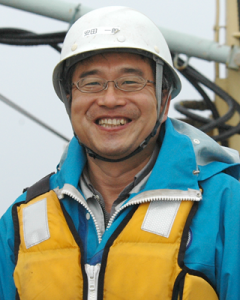Greetings
Welcome to visit our home page.
Probably many people think “What is “Ocean Mixing Study?” which sounds difficult. Here we focus on “vertical mixing” which mixes sea water vertically. When currents as tides override rough bottom topography, internal waves are generated. When the amplitude of this internal wave becomes large and the wave breaks, turbulent eddies mix waters vertically. This vertical mixing transports heat downward from surface, and makes deep water light and maintains deep water upwelling. This heat transport influences on climate through surface heat exchange with the overlying atmosphere. Vertical mixing influences on biological production and carbon cycles through nutrient vertical transport. Nutrient concentration is high in the deep North Pacific where is the end of deep circulation and nutrients are accumulated. Vertical mixing acts to uplift and supply the deep nutrient to upper ocean. Photo-synthesis enhances phytoplankton growth by using carbon in the water and then absorb atmospheric CO2 to compensate lowered carbonate density. Despite of importance, knowledge on vertical mixing and mechanism have not been quite limited because of observational difficulty.
On the other hand, observational and numerical technologies recently have greatly advanced. By developing and performing new vertical mixing observations utilizing Japan observational network, together with integrated physical, chemical and biological observations and developing next-generating numerical models with vertical mixing processes, this project challenges to elucidate vertical mixing and impacts. Western North Pacific, especially around Japan, is the world highest biological CO2 absorption area, and also the very productive area of fisheries: 26% catch in 6% surface area in the world oceans. These high biological productions could be caused by large vertical mixing. It is possible that long-period vertical mixing variability could impact on long-term climate and fisheries variabilities. In this project, with wisdom, we tackle these hypotheses by establishing “Ocean Mixing Study”.


